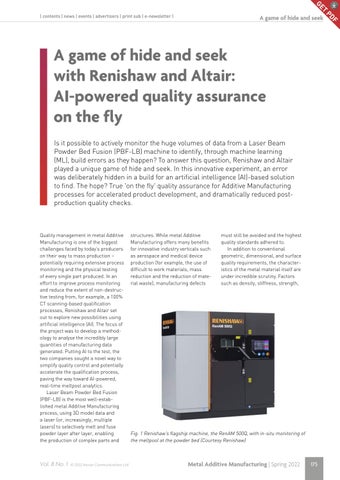T GE A game of hide and seek
A game of hide and seek with Renishaw and Altair: AI-powered quality assurance on the fly Is it possible to actively monitor the huge volumes of data from a Laser Beam Powder Bed Fusion (PBF-LB) machine to identify, through machine learning (ML), build errors as they happen? To answer this question, Renishaw and Altair played a unique game of hide and seek. In this innovative experiment, an error was deliberately hidden in a build for an artificial intelligence (AI)-based solution to find. The hope? True 'on the fly' quality assurance for Additive Manufacturing processes for accelerated product development, and dramatically reduced postproduction quality checks.
Quality management in metal Additive Manufacturing is one of the biggest challenges faced by today’s producers on their way to mass production – potentially requiring extensive process monitoring and the physical testing of every single part produced. In an effort to improve process monitoring and reduce the extent of non-destructive testing from, for example, a 100% CT scanning-based qualification processes, Renishaw and Altair set out to explore new possibilities using artificial intelligence (AI). The focus of the project was to develop a methodology to analyse the incredibly large quantities of manufacturing data generated. Putting AI to the test, the two companies sought a novel way to simplify quality control and potentially accelerate the qualification process, paving the way toward AI-powered, real-time meltpool analytics. Laser Beam Powder Bed Fusion (PBF-LB) is the most well-established metal Additive Manufacturing process, using 3D model data and a laser (or, increasingly, multiple lasers) to selectively melt and fuse powder layer after layer, enabling the production of complex parts and
Vol. 8 No. 1 © 2022 Inovar Communications Ltd
structures. While metal Additive Manufacturing offers many benefits for innovative industry verticals such as aerospace and medical device production (for example, the use of difficult to work materials, mass reduction and the reduction of material waste), manufacturing defects
must still be avoided and the highest quality standards adhered to. In addition to conventional geometric, dimensional, and surface quality requirements, the characteristics of the metal material itself are under incredible scrutiny. Factors such as density, stiffness, strength,
Fig. 1 Renishaw’s flagship machine, the RenAM 500Q, with in-situ monitoring of the meltpool at the powder bed (Courtesy Renishaw)
Metal Additive Manufacturing | Spring 2022
175
F PD
| contents | news | events | advertisers | print sub | e-newsletter |
